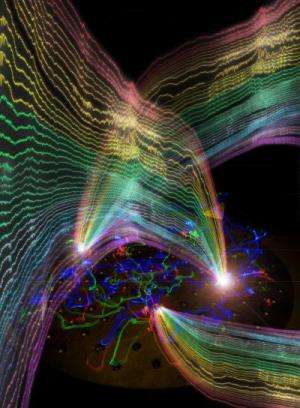Mapping blank spots in the cheeseboard maze

(Medical Xpress)—During spatial learning, space is represented in the hippocampus through plastic changes in the connections between neurons. Jozsef Csicsvari and his collaborators investigate spatial learning in rats using the cheeseboard maze apparatus.
This apparatus contains many holes, some of which are selected to hide food in order to test spatial memory. During learning trials, animals learn where the rewards are located, and after a period sleep, the researchers test whether the animal can recall these reward locations. In previous work, they and others have shown that memory of space is encoded in the hippocampus through changes in the firing of excitatory pyramidal cells, the so-called "place cells". A place cell fires when the animal arrives at a particular location. Normally, place cells always fire at the same place in an environment; however, during spatial learning the place of their firing can change to encode where the reward is found, forming memory maps.
In their new publication, the researchers investigated the timescale of map formation, showing that during spatial learning, pyramidal neuron maps representing previous and new reward locations "flicker", with both firing patterns occurring. At first, old maps and new maps fluctuate, as the animal is unsure whether the location change is transient or long-lasting. At a later stage, the new map and so the relevant new information dominates.
The scientists also investigated the contribution of inhibitory interneuron circuits to learning. They show that these interneurons, which are extensively interconnected with pyramidal cells, change their firing rates during map formation and flickering: some interneurons fire more often when the new pyramidal map fires, while others fire less often with the new map. These changes in interneuron firing were only observed during learning, not during sleep or recall.
The scientists also show that the changes in firing rate are due to map-specific changes in the connections between pyramidal cells and interneurons. When a pyramidal cell is part of a new map, the strengthening of a connection with an interneuron causes an increase in the firing of this interneuron. Conversely, when a pyramidal cell is not part of a new map, the weakening of the connection with the interneuron causes a decrease in interneuron firing rate. Both, the increase and the decrease in firing rate can be beneficial for learning, allowing the regulation of plasticity between pyramidal cells and controlling the timing in their firing.
The new research therefore shows that not only excitatory neurons change modify their behaviour and exhibit plastic connection changes during learning, but also the inhibitory interneuron circuits. The researchers suggest that inhibitory interneurons could be involved in map selection – helping one map dominate and take over during learning, so that the relevant information is encoded.

















